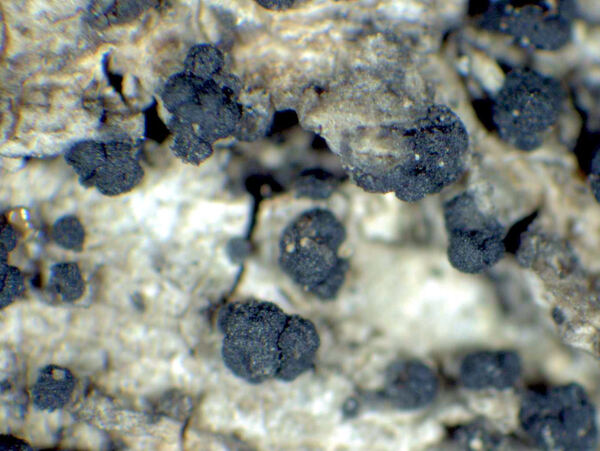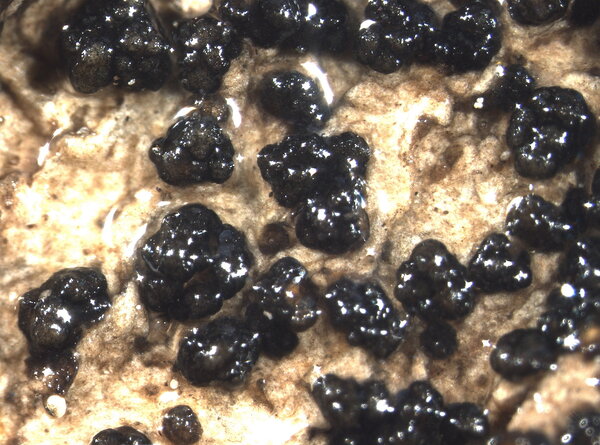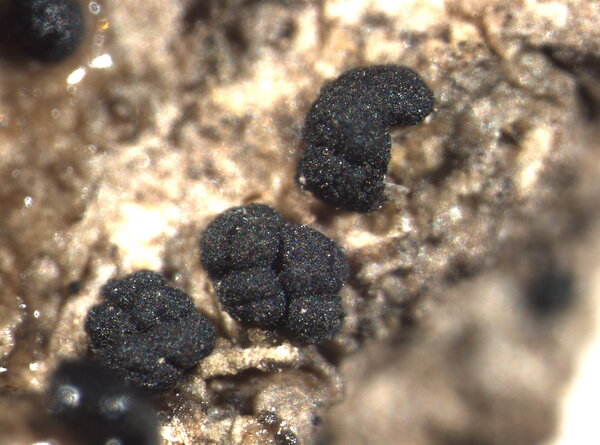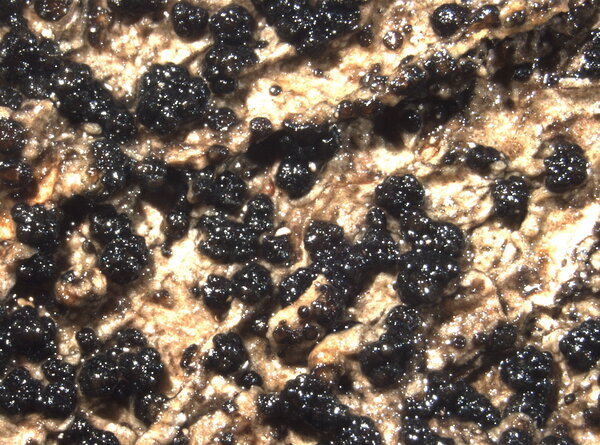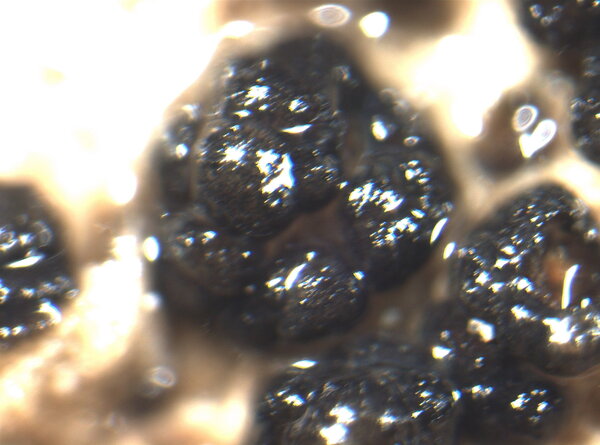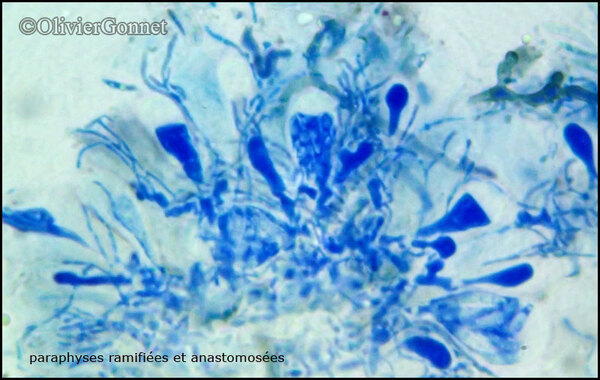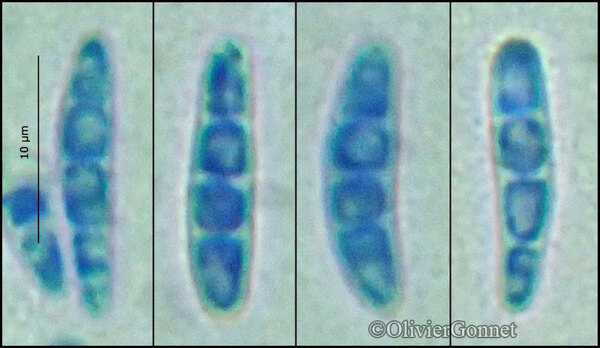Micarea nitschkeana (Rabenh.) Harm.
Bull. Soc. Sc. Nancy, 2, 33: 64, 1899. Basionym: Bilimbia nitschkeana J. Lahm ex Rabenh. - Lich. Eur. Exs.: nr. 583, 1861.
Synonyms: Bacidia nitschkeana (Rabenh.) Zahlbr.; Bacidia spododes (Nyl.) Zahlbr.; Bilimbia spododes (Nyl.) Arnold; Lecidea nitschkeana (Rabenh.) Stizenb.; Lecidea spododes Nyl.
Distribution: N - TAA (Nimis & al. 2015, Nascimbene & al. 2022), Lomb (Alessio & al. 1995). C - Tosc (Loppi & Putortì 2001), Umb (Ravera 2000, Ravera & al. 2006).
Description: Thallus crustose, episubstratic, of convex areoles, rarely endosubstratic and indistinct, whitish-green to pale greenish-grey, ecorticate, usually forming small patches. Apothecia micareoid, sessile, 0.1-0.3(-0.5) mm across, dark grey to black (rarely paler in shade-forms), often confluent, with a strongly convex, epruinose disc, without a proper margin or (in young apothecia only) with a very thin, whitish, soon excluded margin. Proper exciple poorly developed, evident only in very young apothecia, of radiating, paraphysis-like hyphae, the outer part sometimes olivaceous green and K+ violet; epithecium olive-grey, K+ violet, C+ red-violet; hymenium colourless or greenish in upper part, 25-40 µm high, C+ pink; paraphyses numerous, branched and anastomosing, 1-1.5 µm thick, not capitate; hypothecium colourless, 30-40 µm high. Asci 8-spored, clavate to cylindrical-clavate, in K/I with a blue outer layer and apical dome and unstained wall, the dome with an apical cushion. Ascospores (1-)3(-4) septate, hyaline fusiform, slightly curved, (8-)10-17(-20) x 2-3.5(-4) µm. Pycnidia immersed to emergent, grey to black, the wall with a greenish, K+ violet pigment. Conidia of three types: a) macroconidia, curved, 1-3 septate, 12-24 x 1 µm; b) mesoconidia, 1-celled, 3.5-5 x 1-1.5 µm, and, c) microconidia, 1-celled, 5.5-7.5 x 0.7-0.8 µm. Photobiont micareoid, the cells 4-7 μm wide. Spot tests: thallus K-, C- or C+ red, KC- or KC+ red, P - (reactions best observed in thick microscopic sections). Chemistry: variable amounts of gyrophoric acid in thallus and apothecia, sometimes Sedifolia-grey pigment in apothecia and pycnidia. Note: on twigs and small branches of conifers and, more rarely, of acid-barked deciduous trees and small shrubs, occasionally also on lignum. Known from a few localities in the Central Alps and the Northern Apennines. It is included in the Italian red list of epiphytic lichens as “Vulnerable” (Nascimbene & al. 2013c).
Growth form: Crustose
Substrata: bark
Photobiont: green algae other than Trentepohlia
Reproductive strategy: mainly sexual
Commonnes-rarity: (info)
Alpine belt: absent
Subalpine belt: extremely rare
Oromediterranean belt: absent
Montane belt: extremely rare
Submediterranean belt: absent
Padanian area: absent
Humid submediterranean belt: extremely rare
Humid mediterranean belt: absent
Dry mediterranean belt: absent
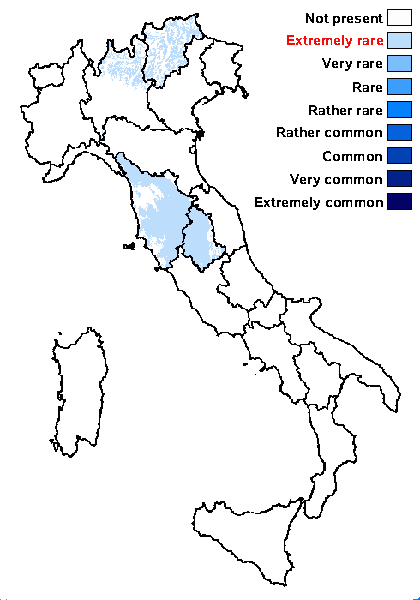
Predictive model
Herbarium samples


P.L. Nimis; Owner: Department of Life Sciences, University of Trieste
Herbarium: TSB (8225)
2001/11/27
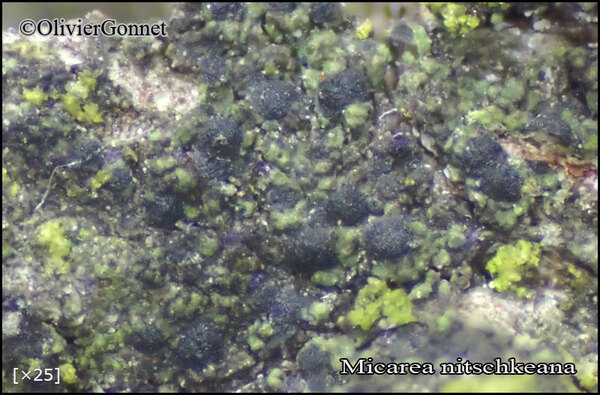
Courtesy Danièle et Olivier Gonnet - Source: https://www.afl-lichenologie.fr/Photos_AFL/Photos_AFL_M/Texte_M2/Micarea_nitschkeana.htm
France, Thoiry, 1315 m - Ain - (01) - sur écorce de Pinus
26/8/2017
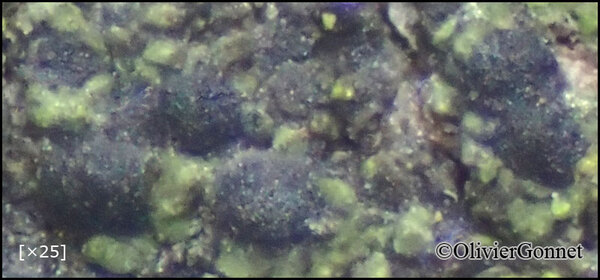
Courtesy Danièle et Olivier Gonnet - Source: https://www.afl-lichenologie.fr/Photos_AFL/Photos_AFL_M/Texte_M2/Micarea_nitschkeana.htm
France, Thoiry, 1315 m - Ain - (01) - sur écorce de Pinus
26/8/2017
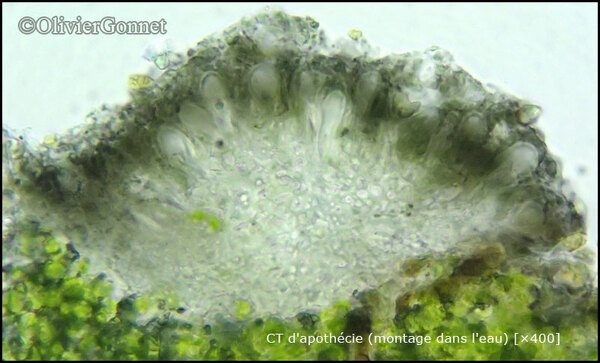
Courtesy Danièle et Olivier Gonnet - Source: https://www.afl-lichenologie.fr/Photos_AFL/Photos_AFL_M/Texte_M2/Micarea_nitschkeana.htm
France, Thoiry, 1315 m - Ain - (01) - sur écorce de Pinus
26/8/2017

Courtesy Danièle et Olivier Gonnet - Source: https://www.afl-lichenologie.fr/Photos_AFL/Photos_AFL_M/Texte_M2/Micarea_nitschkeana.htm
France, Thoiry, 1315 m - Ain - (01) - sur écorce de Pinus
26/8/2017
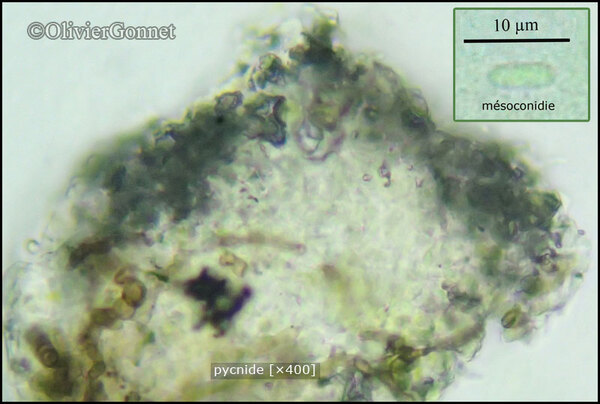
Courtesy Danièle et Olivier Gonnet - Source: https://www.afl-lichenologie.fr/Photos_AFL/Photos_AFL_M/Texte_M2/Micarea_nitschkeana.htm
France, Thoiry, 1315 m - Ain - (01) - sur écorce de Pinus
26/8/2017
Growth form: Crustose
Substrata: bark
Photobiont: green algae other than Trentepohlia
Reproductive strategy: mainly sexual
Commonnes-rarity: (info)
Alpine belt: absent
Subalpine belt: extremely rare
Oromediterranean belt: absent
Montane belt: extremely rare
Submediterranean belt: absent
Padanian area: absent
Humid submediterranean belt: extremely rare
Humid mediterranean belt: absent
Dry mediterranean belt: absent

Predictive model
| Herbarium samples |


P.L. Nimis; Owner: Department of Life Sciences, University of Trieste
Herbarium: TSB (8225)
2001/11/27

Courtesy Danièle et Olivier Gonnet - Source: https://www.afl-lichenologie.fr/Photos_AFL/Photos_AFL_M/Texte_M2/Micarea_nitschkeana.htm
France, Thoiry, 1315 m - Ain - (01) - sur écorce de Pinus
26/8/2017

Courtesy Danièle et Olivier Gonnet - Source: https://www.afl-lichenologie.fr/Photos_AFL/Photos_AFL_M/Texte_M2/Micarea_nitschkeana.htm
France, Thoiry, 1315 m - Ain - (01) - sur écorce de Pinus
26/8/2017

Courtesy Danièle et Olivier Gonnet - Source: https://www.afl-lichenologie.fr/Photos_AFL/Photos_AFL_M/Texte_M2/Micarea_nitschkeana.htm
France, Thoiry, 1315 m - Ain - (01) - sur écorce de Pinus
26/8/2017

Courtesy Danièle et Olivier Gonnet - Source: https://www.afl-lichenologie.fr/Photos_AFL/Photos_AFL_M/Texte_M2/Micarea_nitschkeana.htm
France, Thoiry, 1315 m - Ain - (01) - sur écorce de Pinus
26/8/2017

 INDEX FUNGORUM
INDEX FUNGORUM
 GBIF
GBIF
 DOLICHENS
DOLICHENS
